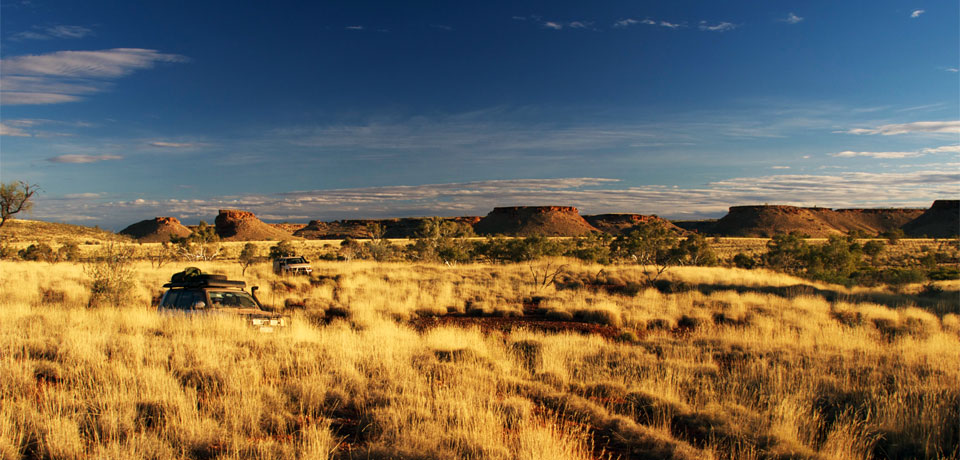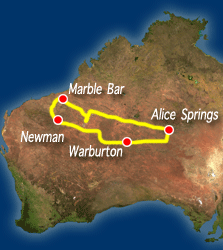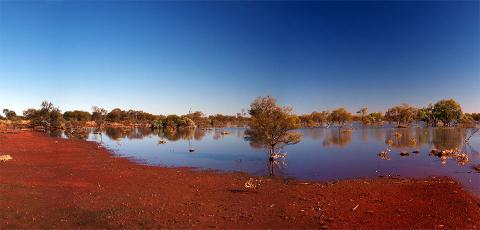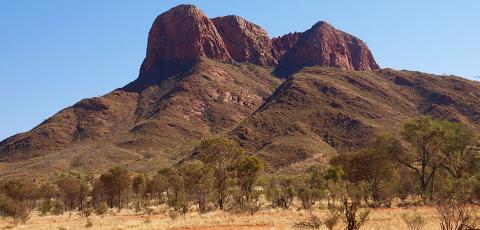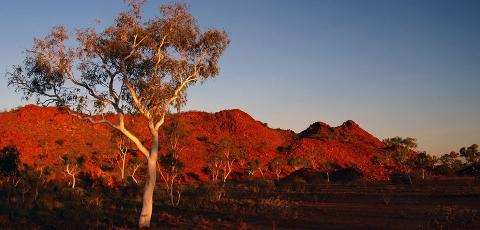Red Centre to the Pilbara Expedition - seat in vehicle
- Durata: 17 Giorni
- Codice prodotto: rcp
This is the ultimate Western Deserts Safari. If you have been looking at a map of Australia and wondering what mysteries lie in the blank bits out west - look no further. Rather than a barren desert, you will find nature's wonderland, including the Mulga parklands of the Gibson Desert Nature Reserve, the rugged splendour of Rudall River National Park, and the stunning and seldom visited East Pilbara. See how the country changes, and how the plants, birds and wildlife adapt to those changes. This expedition travels through the communities of Haasts Bluff, Papunya, Warburton, Warakurna and Kiwirrkurrna. You will travel the paths of the explorers as well as tracks put in by Len Beadell, including the Gary and Gunbarrel highways and the seldom-travelled Talawanna Track. For lovers of nature, those with an adventurous spirit, or simply those who love to immerse themselves in wild and remote places, look no further, this is the one for you.
Day One
From Alice Springs we head along Larapinta Drive through the Western MacDonnell Ranges to Glen Helen, where the Finke River cuts a spectacular gorge through the range. We travel to the community of Haasts Bluff, home to Luritja and some Pintubi people. The Ikuntji Art Centre has developed over the past few years into a vibrant and productive project. Further on at the foot of Haasts Bluff is a memorial to Frederick Blakeley, an explorer and prospector of the early 1900's whose primary claim to fame was that his favoured means of transport in the outback was the bicycle, which he considered to be superior to the horse. We then head to the Papunya Tjipi art center at Papunya. We camp in view of the magnificent massif of Mt. Liebig, at 5000’ one of the highest peaks in Central Australia.
Day Two
Our first morning back in the outback. Awake to birdsong, and after breakfast head off for a walk while we pack the vehicles. We head west along the Gary Junction Road, originally built by Len Beadell as part of the Woomera long distance weapons project. Len constructed the road between August and November 1960. The road is maintained in good condition and travels along spectacular country interspersed with dramatic ranges. We visit Sandy Blight Junction and continue on past the Western Australian border and take an early camp at the scenic Dovers Hills.
Day Three
We travel on to Kiwirrkurra. Considered the most remote Aboriginal community in Australia, Kiwirrkurra is home to the Pintubi people. It is a dry community. We visit the Women’s Centre and the Art Centre, where Papunya Tula artists work. We also visit Len Beadell's burned out mess truck and the community store. We continue along the track west, where the Acacia woodland begins to give way to the sandhills of the Great Sandy Desert.
Day Four
The road continues west through expansive country, vast Spinifex plains interspersed with patches of acacia woodland, and stands of flowering grevillea. We enter an extensive desert oak forest, and visit Jupiter Well. There is a Beadell marker at Gary Junction, after signing the visitors book we take the Jenkins Track through to the Canning Stock Route. We take on water at Well 33. At Kunawarritji Aboriginal Community there is a shower, and the chance to purchase limited items at the newly constructed shop while taking in the ambience of this remote western desert community. We continue west and camp near the banks of Lake Auld at Burrow Bore.
Day Five
We travel to the community of Punmu, situated curiously on the shore of the saline Lake Dora. Almost reminiscent of a seaside town, other than the fact there is no water and we are in the middle of the Great Sandy Desert! We continue on to lunch on an unnamed high knoll with spectacular views over the surrounding desert. We pass by the Telfer Mine. This is a huge project , the largest gold mine in Australia operated by Newcrest involving two open cut and one underground mine. The gold is processed on site and the gold copper concentrate is trucked to Port Headland to be shipped, mainly to East Asia. That would mean the roads ahead improve – but not for us, we are heading south towards the remote and spectacular Karlamilyi (Rudall River) National Park. The sandhills finally recede, and we enter the Throssel Range. We take a break at the Duck Pond, a beautiful water filled gorge on the Coolbro Creek and continue on to our camp on an unnamed claypan surrounded by Spinifex coated red rocky ranges punctuated with white gums. This will be our base for the next two nights.
Day Six
There is more stunning rangeland as the track winds south. We stop at an abandoned exploration camp replete with a hand pump for extracting crystal clear drinking water, and shortly after enter Karlamilyi National Park. Its name was changed in 2008 from Rudall River National Park to formally acknowledge the traditional owners. At 1,283,706 hectares it is largest National Park in Western Australia, and two and a half time the size of the Grand Canyon National Park in Arizona, but due to its remoteness it receives little visitation. We travel past the singular Compton Pinnacle, slowly picking our way across creek lines and washaways down to the Desert Queen Baths, a steep gorge punctuated with a series of waterholes. We explore the gorge, including Aboriginal paintings and petroglyphs, and those who don’t mind cold water can take a dip in the bracing pools. In the late afternoon we return to camp.
Day Seven
We retrace our drive north for around 30 kms to a round dome like hill named Moses Chair by the explorer Frank Hann, before turning north west onto a seldom travelled access track through the western- most sandhills of the Great Sandy Desert. We travel through the Nifty Copper mine and on to the Woodie Woodie Mine, which marks our entry into the East Pilbara. 700 people, mainly fly in fly out, live and work here. Operated by Consolidated Minerals, which was the subject of a hostile takeover by Ukrainian billionaire Gennadiy Bogolyubov, the mine extracts high quality Manganese mainly for use in stainless steel production. It appears out of nowhere, and thankfully disappears in the rear vision mirror equally as quickly, the main advantage being the road improves beyond Woodie. We take a lunch break beneath giant melaleucas and river red gums at a waterhole in the Oakover River. Ringed by giant Melaleuca trees, this waterhole is one of the most beautiful in the outback. The afternoon is spent enjoying one of the more remote and less visited parts of the East Pilbara. We take a walk to explore the magnificent Upper Carrwine Gorge, ascending the walls of the gorge to gaze out over a vast sheet of water.
Day Eight
After breakfast we head to Eel Pool for a morning swim in one of the outback’s most delightful swimming holes. Surrounded by huge trees and tangled roots, the warm crystal clear spring fed water is a delight. We then take the Skull Springs Road through to Nullagine, through scenery that looks like a Fred Williams painting. We arrive at Marble Bar and drop in to the Iron Clad Hotel, a corrugated iron pub now on the Western Australian State heritage register. We head west to our camp on the Coongan River at Doolena Gorge.
Day Nine
We return to Marble Bar and visit the museum before heading out to the fabled "Bar", a reef of striped red white and blue Jasper that forms a bar on the Coongan River. We travel along the Hillside Track geological trail, visiting Glen Herring Gorge. We camp amidst stunning Granite Tors. This is our most north westerly camp.
Day Ten
We travel south along the Port Headland road to the Auski Roadhouse. A chance to freshen up at the Caravan Park in Newman, visit the delightful Newman shopping Mall, where one can enjoy Newman café society while we reprovision for the next leg of our adventure. We refuel alongside the Road Trains at the Capricorn Roadhouse, one of Australia’s busiest, before heading to our camp in Acacia woodland north of Newman.
Day Eleven
Our arrival at a Len Beadell marker signifies our return to the Great Sandy Desert, this time, east along the Talawana Track. We cross the tributary of the Oakover River and the original Rabbit Proof Fence. We fuel up at Parngurr community ahd travel to Georgia Bore on the Canning Stock Route. After topping up our water supplies from the hand pump we continue on to camp just beyond Well 23 on the Canning.
Day Twelve
We travel for 10 kms further along the Canning Stock Route before turning east to take the path less travelled along the Talawana Track, also constructed by Len Beadell. As we leave the stock route, the country flattens out and we find ourselves in wide open vast sandhill terrain . This is truly remote, seldom travelled country, offering spectacular vistas. We visit Midway Well, a native well that provided welcome relief for Larry Wells on the ill feted Calvert Expedition in 1907. Eventually the sandhills give way to the laterite plains and acacia woodlands of the Gibson Desert.
Day Thirteen
After a delightful drive through acacia woodland , mulga thickets and Spinifex grasslands we arrive at Windy Corner. No prizes for working out why Len named it such, but it is the culmination of our run along the Talawanna Track, and our junction with the Gary Highway, which will take us south to the Gunbarrel. A spectacular view of the surrounding desert is obtained from the summit of McDougall’s Knob. We contine south across rangeland and enter the Gibson Desert Nature Reserve. We camp at the ephemeral Lake Cohen, which when full is an important stop for migratory birds.
Day Fourteen
A full day in the Gibson Desert Nature Reserve. This magnificent remote and seldom visited park is an absolute delight with its mulga parkland over lateritic plains interspersed with ephemeral clay pans like Lake Cohen that provide refuge for migratory birds. There are also occasional sandstone mesas that rise up punctuating the landscape. It is a feast for the eyes.We climb McPhersons Pillar, and Mulgan Rockhole. Crossing Charlies Knob with its expansive views and curious sculptures we arrive at Everard Junction. We turn east along the legendary Gunbarrel Highway.
Day Fifteen
From Mt Everard we head south east to Mt. Beadell. The more athletic can hike to the summit, where a theodolite in a cage provides a memorial to Len Beadell. The track continues on past spectacular rangeland to Notabilis Hill and on to our camp on the Heather Highway.
Day Sixteen
This morning we arrive in Warburton. We visit the Tjulyuru Arts Centre that contains some stunning examples of slump glasswork. Taparti Bates won a Normanby art prize with this glasswork. We visit Giles Meteorological Station and its museum. We will stop at the Warakurna Roadhouse and continue on to our camp with a view of the spectaculare Schwerin Mural Crescent, a rugged range named by Ernest Giles in 1874.
Day Seventeen
The road crosses he Northern Territory Border at Docker River. We pay a visit to Lasseter's Cave, where the fabled explorer sheltered before setting off east to his death. we travel east past the Petermann Ranges and stop on a red sandhill to view Kata Tjuta, before arriving at Yulara Ayers Rock Resort. There is the option to leave the tour here or continue north to arrive at Alice Springs Hotels early evening.
